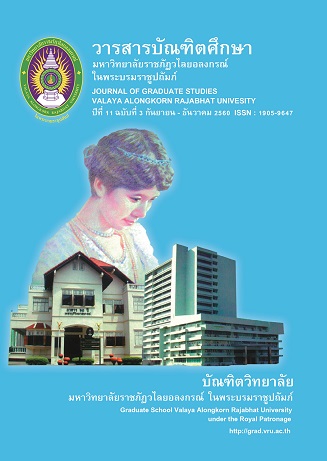ศักยภาพในการเป็นแหล่งท่องเที่ยวเชิงพุทธของวัดในจังหวัดปทุมธานี
Main Article Content
Abstract
บทคัดย่อ
การวิจัยนี้มีวัตถุประสงค์หลักเพื่อประเมินศักยภาพในการเป็นแหล่งท่องเที่ยวเชิงพุทธ ของวัดในจังหวัดปทุมธานี โดยใช้ระเบียบวิธีวิจัยแบบผสานวิธี ประกอบด้วยการวิจัยเชิงปริมาณ และเชิงคุณภาพ ในการประเมินศักยภาพของวัดดังกล่าว สำหรับการวิจัยเชิงปริมาณจะใช้แบบประเมินเป็นเครื่องมือในการประเมิน โดยมีผู้ประเมิน 3 กลุ่ม คือ (1) ผู้เชี่ยวชาญด้านพระพุทธศาสนา จากสำนักงานพระพุทธศาสนา, (2) ผู้นำชุมชน, และ (3) นักวิจัย การวิจัยนี้ได้ใช้วิธีการสนทนากลุ่ม และการสัมภาษณ์เชิงลึก ในการเก็บข้อมูลเชิงคุณภาพ
ผลการวิจัยพบว่า จังหวัดปทุมธานีมีวัดจำนวน 186 วัด โดยมีวัดที่มีศักยภาพในการท่องเที่ยวสูง มีจำนวน 39 วัด ที่มีศักยภาพในการเป็นแหล่งท่องเที่ยวเชิงพุทธในระดับที่สูง สำหรับวัดอีก 147 วัด พบว่ามีศักยภาพในระดับปานกลาง การศึกษาครั้งนี้ยังได้นำเสนอวัดในจังหวัดปทุมธานีที่ทรงคุณค่าใน 4 ด้าน ได้แก่ (1) ชื่อเสียงของเกจิอาจารย์ (2) รูปเคารพ และวัตถุมงคล (3) สถาปัตยกรรม และจิตรกรรม และ (4) สถานปฏิบัติธรรม
ABSTRACT
The main objective of this research is to evaluate the Buddhist tourism potential of all temples located in Pathum Thani province. Integration methods include both quantitative and qualitative methods to evaluate the potential of the temples. For the quantitative method, the study uses an evaluation form as a tool to evaluate Buddhist tourist destination. Evaluators of various fields, comprising the expert from the Buddhist department, community leaders, and researchers, take an effort on focus group and depth-interview in order to get solution.
The research results find that there are 186 temples in Pathum Thani province. Thirty nine temples make up the group with a high potential for Buddhist tourism. The others, 147 temples have moderate level in potential. This study also presents the temples that have well recognized in potential into four aspects (1) well-known monks, (2) sacred objects, (3) secco and architecture, and (4) dhamma retreat.
Article Details
บทความทุกเรื่องได้รับการตรวจความถูกต้องทางวิชาการโดยผู้ทรงคุณวุฒิ ทรรศนะและข้อคิดเห็นในบทความวารสารบัณฑิตศึกษา มหาวิทยาลัยราชภัฏวไลยอลงกรณ์ ในพระบรมราชูปถัมภ์ มิใช่เป็นทรรศนะและความคิดของผู้จัดทำจึงมิใช่ความรับผิดชอบของบัณฑิตวิทยาลัย มหาวิทยาลัยราชภัฏวไลยอลงกรณ์ ในพระบรมราชูปถัมภ์ กองบรรณาธิการไม่สงวนสิทธิ์การคัดลอก แต่ให้อ้างอิงแหล่งที่มา


